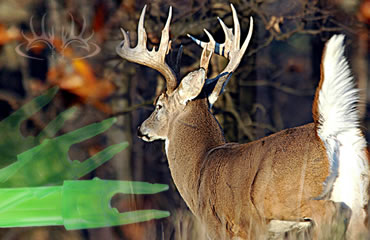Last season, I learned a valuable lesson about not paying attention to nock tightness, and what can happen if you don’t re-snap your arrow to the string after drawing your bow. It might seem like small detail, but it could have big consequences.
Here’s how a nock that lost its gripping power caused me to miss the buck of a lifetime as well as ruin my prized bow.
It was mid-September, and the conditions were perfect for the evening’s hunt.
Just as the sun began to set, I caught movement on the old logging road I was watching. A young and impressive 8-pointer walked right past, making its way to a nearby cornfield, but it stopped to graze on a patch of grass at the field’s edge.
I passed up the youngster, knowing it was a couple of years from being a giant, and I enjoyed observing it just a few yards away.
The 8-pointer would sporadically look up and stare nervously into the thick brush behind it. This was a good sign that a dominant buck could be coming.
When I caught slight flashes of movement in the woods, I struggled to see if it was indeed an alpha buck.
Five minutes passed, and then suddenly, there it was! An old, wide-beamed buck with long brow tines, heavy mass and lots of tines appeared. It had everything a hunter could dream of!
The monster walked past my stand, just like the smaller buck, and I drew my bow when it got to the small patch of green stuff.
I waited for it to take two more steps and turn broadside at 15 yards, but it never offered a good angle. Quietly, I let my bowstring down.
After 30 seconds of grazing, the buck turned for a perfect shot angle.
I drew my bow again, placed my pin on the buck’s armpit and touched the trigger on my release. In my mind, this buck was already mine.
CRACK! My arrow toppled off the string, hit my treestand on its way to earth, and sent both bucks running back into the woods.
“What happened?” I asked aloud.
Unbeknown to me, the first time I drew the bow, the old, loose nock unsnapped from the string but was still resting on the nock point.
So, when I drew again, the arrow simply slipped off. This meant I dry-fired my bow, which caused a nearly two-inch crack in a limb. Consequently, the bow had to be retired.
Losing the bow was bad, but I was more devastated about losing what should have been the largest buck of my hunting career.
If you shoot a lot and don’t replace your nocks, they will wear down over time, so be aware of that tidbit. You can try heating them with a hairdryer or in boiling water, then pinching them tighter with pliers. But your best bet is to simply replace the nock.
Details like this are important in hunting, and I hope my sad story might educate fellow hunters so they won’t have something similar happen to them.
– Editor’s Note by Tim H. Martin
I have a sad tale similar to Scott Stricker’s. Thankfully, it only involved a meat doe, not a giant buck like his.
I had drawn my arrow on the doe, but got tired of holding and had to let it back down. The next time I drew, the arrow fell off the string and landed on the ground. Bye-bye, venison.
Even with fairly tight nocks this can happen, especially with modern, short-limbed bows. Many have a steeper string angle (when drawn) than older models, so re-snapping the nock to the string is something you’ll really have to be conscious of.
So, be advised: Always re-snap your nock to the string if you have to draw and let back down. Little things make a big difference!
Read Recent Tip of the Week:
• Open Field Yardage Markers: There are trees, rocks, creeks, stumps and other objects to range yardages in the woods, but what about open fields? Here’s a nifty tip!




.png)